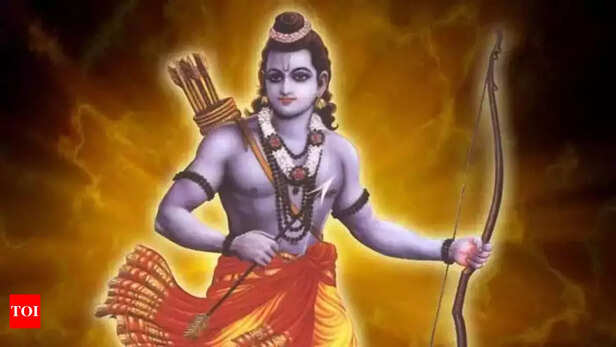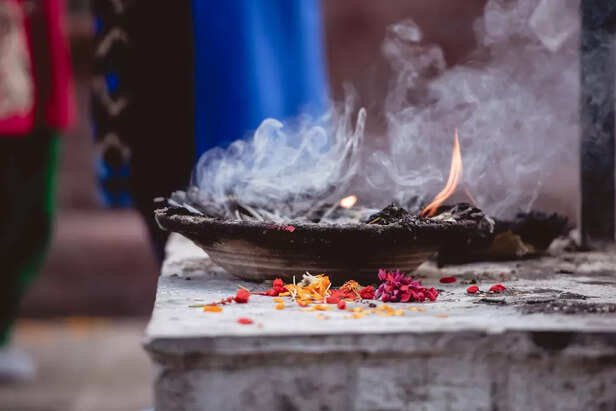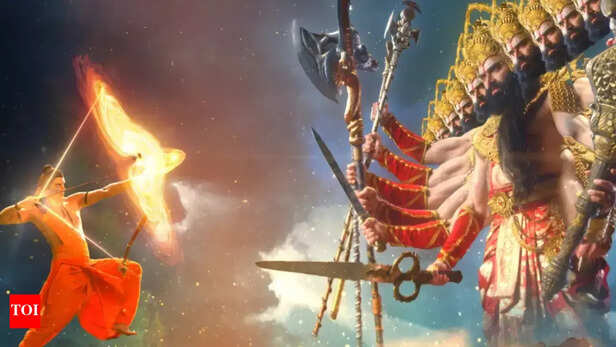Why did Shri Rama worship Devi Durga in Ramayana?
Ankit Gupta | Apr 06, 2025, 14:41 IST
Devi Durga
Shri Rama worshipped Devi Durga in the Ramayana—specifically in the Bengali retellings and the later devotional traditions, rather than in Valmiki's original version—to seek Her blessings for victory over Ravana. This episode is especially prominent in the Krittivasi Ramayana, a 15th-century Bengali rendition of the epic by poet Krittibas Ojha.
“Ya Devi Sarvabhuteshu Shakti-Rupena Samsthita
Namastasyai Namastasyai Namastasyai Namo Namah”
– Devi Mahatmya
In the grand cosmos of Sanatan Dharma, every action, every moment, and every season carries divine symbolism. But sometimes, a profound event rewrites the script of eternity, ushering in a new spiritual tradition. One such epochal moment occurred in the Ramayana, not in its more familiar telling by Valmiki, but in the deeper, more devotional streams of regional and Tantric retellings—where the eternal roles of the Divine Masculine and Divine Feminine intersect in breathtaking ways.
This is the story of Akal Bodhan, the untimely invocation of Devi Durga by none other than Shri Rama, and how it changed the religious fabric of Bharat forever.
Rama,

As the battle in Lanka reached its crescendo, a lesser-known but deeply symbolic incident unfolds. Ravana, the mighty emperor of Lanka, desperate to avoid defeat, hatches a secret plan. He calls upon his brother Mahiravana, the sorcerer-king of Pātāla Loka, to abduct Shri Rama and Lakshmana under the cover of night.
Mahiravana, master of illusions and tantric arts, succeeds. Shri Rama and Lakshmana vanish. But Hanuman, ever-vigilant, follows them into the netherworld. In a dramatic sequence, Hanuman slays Mahiravana, rescues the divine brothers, and obliterates the last shadows of deception in Ravana’s arsenal.
The news of Mahiravana’s death reaches Ravana. The indomitable king, for the first time, feels the cold breath of fate on his shoulder. In his desperation, he abandons pride and arrogance and does the unthinkable—he calls upon the Divine Mother herself.

The battlefield falls silent as Ravana, wounded in both body and spirit, stands alone. Bloodied but defiant, he lifts his eyes to the heavens and cries out:
"O Jagat Janani! Even Mahadeva has abandoned me. O Mother, it is only you who never forsakes your children. You are my last refuge!"
And then, something miraculous happens. The Divine Mother answers.
In a moment that stuns the universe, Devi Durga descends, radiant and terrible, her compassion matching her fury. Seeing the once-proud Ravana now weeping like a child, she steps forward and lifts him into her lap.
"Fear not, my child," she whispers. "I shall protect you. Even if the world turns against you, I shall not."
The devas gasp. Rama, Lakshmana, Indra, Brahma—all are thunderstruck. How can Ravana now be defeated? With the power of Shakti behind him, Ravana has become invincible.

The devas turn to Brahma, the creator, for a solution. Brahma, deep in meditation, sees the threads of fate. He tells Shri Rama:
"There is but one way. You must worship the Mother yourself. Only Her grace can balance Her protection of Ravana. You must invoke Her through the ritual of Akal Bodhan—worshiping the Goddess out of season."
Rama is puzzled. "But Mother is worshipped during the Chaitra month (spring), and that time has passed. Can I truly invoke Her now, in Ashvin?"
Brahma smiles. "Such is Her compassion that She will respond to true devotion, even outside her usual season. That is Akal Bodhan—untimely invocation. Do it now, and you shall see Her grace flow like the Ganges in flood."

Determined, Rama agrees. The battlefield is transformed into a mandala of devotion. The Goddess is to be worshipped with 108 Neela Pankaja (blue lotuses)—a rare flower symbolizing the deepest devotion.
Hanuman, ever faithful, leaps across the lakes and forests, collecting the lotuses one by one. But as the puja begins, it is discovered that only 107 are present. One is missing.
Devi Herself had hidden it—to test Rama’s bhakti.
Without hesitation, Rama prepares to offer something no one expected—his own eye.
"I am called Padma Lochana—the lotus-eyed one," he says. "Let me offer this eye in place of the lotus that is missing."
Just as he is about to pierce his eye with an arrow, the skies roar with thunder.
Devi Durga appears.
Touched by Rama’s devotion, Devi stops him and reveals herself in full splendor.
"O Rama, your devotion pierces even my eternal heart. I hid the lotus to test your love. You have proven that your surrender is complete."
She then unveils the great cosmic drama behind Ravana’s existence.
"Ravana is not just a king; he is one of the two gatekeepers of Vaikuntha, cursed to be born in mortal form. This war is but the unfolding of a divine curse. Only on the Dashami tithi of the Ashvin month, can he be released. That is the destined moment of his end."
With this revelation, Devi blesses Rama and disappears. A new path is forged—not only for Rama but for humanity.

On the Dashami tithi, Rama returns to battle. Armed with the blessings of the Devi, he finally slays Ravana, cutting down his ten heads, one by one, with the invincible Brahmastra.
The skies resound with the cries of “Jai Shri Rama!” and “Durga Mata ki Jai!”
This glorious victory is celebrated as Vijaya Dashami—the Day of Victory. But its spiritual foundation lies deeper. It marks the moment when the worship of Devi Durga during Ashvin month—instead of Chaitra—was established by none other than Shri Rama himself.
Prior to this divine intervention, Devi Durga was primarily worshipped in spring (Chaitra Navratri). But Rama’s Akal Bodhan gave rise to a new tradition—the autumnal worship known as Sharadiya Navratri.
In this tradition, devotees remember not just Durga’s battle with Mahishasura, but also Shri Rama’s surrender to the Mother, his devotion, his offering of the eye, and the miracle of Ravana’s defeat.
The festival became a fusion of Shakta and Vaishnav traditions—where Vishnu’s avatar bows before the Goddess, and together they preserve dharma.
This incident is more than a tale of devotion or divine intervention—it is a profound philosophical statement about the harmony of opposites.
This is the depth of Sanatan Dharma—a tradition where the lines between good and evil blur, revealing the deeper unity of all things.
Today, as Durga Puja unfolds in Bengal and across India during the Ashvin month, most devotees remember the Goddess slaying the demon Mahishasura.
But few remember that this tradition itself was born from a moment of divine desperation, love, and surrender—from Shri Rama’s invocation of the Mother in the battlefield.
Each drumbeat of the dhak, each chant of “Ya Devi Sarvabhuteshu”, each crafted idol of Durga holding her weapons, carries with it echoes of that moment when the lotus-eyed prince offered his eye in place of a flower.
The tale of Akal Bodhan is not merely a deviation from traditional Ramayana—it is its spiritual peak, where bhakti surpasses ritual, and grace overpowers fate.
Rama, the king, became the devotee. Ravana, the villain, became the child. And Durga, the Mother, embraced them both.
From that day on, the calendar of the gods shifted, and Ashvin became the sacred month of Devi’s descent.
Akal Bodhan teaches us that the divine is not bound by time, and that true devotion can invoke grace even in the most untimely of hours.
It reminds us that when all paths are lost, one need only call out:
"O Mother!"
And She will come—lift us in Her arms, and guide us home.
Namastasyai Namastasyai Namastasyai Namo Namah”
– Devi Mahatmya
In the grand cosmos of Sanatan Dharma, every action, every moment, and every season carries divine symbolism. But sometimes, a profound event rewrites the script of eternity, ushering in a new spiritual tradition. One such epochal moment occurred in the Ramayana, not in its more familiar telling by Valmiki, but in the deeper, more devotional streams of regional and Tantric retellings—where the eternal roles of the Divine Masculine and Divine Feminine intersect in breathtaking ways.
This is the story of Akal Bodhan, the untimely invocation of Devi Durga by none other than Shri Rama, and how it changed the religious fabric of Bharat forever.
Rama, Ravana , and the Descent into Pātāla

Shri Ram
As the battle in Lanka reached its crescendo, a lesser-known but deeply symbolic incident unfolds. Ravana, the mighty emperor of Lanka, desperate to avoid defeat, hatches a secret plan. He calls upon his brother Mahiravana, the sorcerer-king of Pātāla Loka, to abduct Shri Rama and Lakshmana under the cover of night.
Mahiravana, master of illusions and tantric arts, succeeds. Shri Rama and Lakshmana vanish. But Hanuman, ever-vigilant, follows them into the netherworld. In a dramatic sequence, Hanuman slays Mahiravana, rescues the divine brothers, and obliterates the last shadows of deception in Ravana’s arsenal.
The news of Mahiravana’s death reaches Ravana. The indomitable king, for the first time, feels the cold breath of fate on his shoulder. In his desperation, he abandons pride and arrogance and does the unthinkable—he calls upon the Divine Mother herself.
Ravana’s Cry to the Divine Mother

Ravan
The battlefield falls silent as Ravana, wounded in both body and spirit, stands alone. Bloodied but defiant, he lifts his eyes to the heavens and cries out:
"O Jagat Janani! Even Mahadeva has abandoned me. O Mother, it is only you who never forsakes your children. You are my last refuge!"
And then, something miraculous happens. The Divine Mother answers.
In a moment that stuns the universe, Devi Durga descends, radiant and terrible, her compassion matching her fury. Seeing the once-proud Ravana now weeping like a child, she steps forward and lifts him into her lap.
"Fear not, my child," she whispers. "I shall protect you. Even if the world turns against you, I shall not."
The devas gasp. Rama, Lakshmana, Indra, Brahma—all are thunderstruck. How can Ravana now be defeated? With the power of Shakti behind him, Ravana has become invincible.
Brahma’s Counsel

Lord Brahma
The devas turn to Brahma, the creator, for a solution. Brahma, deep in meditation, sees the threads of fate. He tells Shri Rama:
"There is but one way. You must worship the Mother yourself. Only Her grace can balance Her protection of Ravana. You must invoke Her through the ritual of Akal Bodhan—worshiping the Goddess out of season."
Rama is puzzled. "But Mother is worshipped during the Chaitra month (spring), and that time has passed. Can I truly invoke Her now, in Ashvin?"
Brahma smiles. "Such is Her compassion that She will respond to true devotion, even outside her usual season. That is Akal Bodhan—untimely invocation. Do it now, and you shall see Her grace flow like the Ganges in flood."
The Preparation: A Puja Like None Before

Puja
Determined, Rama agrees. The battlefield is transformed into a mandala of devotion. The Goddess is to be worshipped with 108 Neela Pankaja (blue lotuses)—a rare flower symbolizing the deepest devotion.
Hanuman, ever faithful, leaps across the lakes and forests, collecting the lotuses one by one. But as the puja begins, it is discovered that only 107 are present. One is missing.
Devi Herself had hidden it—to test Rama’s bhakti.
Without hesitation, Rama prepares to offer something no one expected—his own eye.
"I am called Padma Lochana—the lotus-eyed one," he says. "Let me offer this eye in place of the lotus that is missing."
Just as he is about to pierce his eye with an arrow, the skies roar with thunder.
Devi Durga appears.
The Divine Intervention and the Secret of Ravana
"O Rama, your devotion pierces even my eternal heart. I hid the lotus to test your love. You have proven that your surrender is complete."
She then unveils the great cosmic drama behind Ravana’s existence.
"Ravana is not just a king; he is one of the two gatekeepers of Vaikuntha, cursed to be born in mortal form. This war is but the unfolding of a divine curse. Only on the Dashami tithi of the Ashvin month, can he be released. That is the destined moment of his end."
With this revelation, Devi blesses Rama and disappears. A new path is forged—not only for Rama but for humanity.
The Death of Ravana and the Birth of Vijaya Dashami

Vijaya Dashami
On the Dashami tithi, Rama returns to battle. Armed with the blessings of the Devi, he finally slays Ravana, cutting down his ten heads, one by one, with the invincible Brahmastra.
The skies resound with the cries of “Jai Shri Rama!” and “Durga Mata ki Jai!”
This glorious victory is celebrated as Vijaya Dashami—the Day of Victory. But its spiritual foundation lies deeper. It marks the moment when the worship of Devi Durga during Ashvin month—instead of Chaitra—was established by none other than Shri Rama himself.
The Tradition of Sharadiya Navratri
In this tradition, devotees remember not just Durga’s battle with Mahishasura, but also Shri Rama’s surrender to the Mother, his devotion, his offering of the eye, and the miracle of Ravana’s defeat.
The festival became a fusion of Shakta and Vaishnav traditions—where Vishnu’s avatar bows before the Goddess, and together they preserve dharma.
Philosophical Reflections: When Shakti and Vishnu Embrace
- Shri Rama, the Maryada Purushottam, upholder of cosmic order, seeks refuge in Devi Durga, the Mahashakti, the cosmic energy behind all motion.
- Ravana, often seen as the villain, is shown here as a child of the Mother, evoking sympathy, showing that the Divine does not discriminate between her children.
- The conflict is not good vs. evil, but ego vs. surrender, pride vs. devotion, karma vs. grace.
This is the depth of Sanatan Dharma—a tradition where the lines between good and evil blur, revealing the deeper unity of all things.
The Living Memory of Akal Bodhan
But few remember that this tradition itself was born from a moment of divine desperation, love, and surrender—from Shri Rama’s invocation of the Mother in the battlefield.
Each drumbeat of the dhak, each chant of “Ya Devi Sarvabhuteshu”, each crafted idol of Durga holding her weapons, carries with it echoes of that moment when the lotus-eyed prince offered his eye in place of a flower.
A Devotion That Redefined Time
Rama, the king, became the devotee. Ravana, the villain, became the child. And Durga, the Mother, embraced them both.
From that day on, the calendar of the gods shifted, and Ashvin became the sacred month of Devi’s descent.
Akal Bodhan teaches us that the divine is not bound by time, and that true devotion can invoke grace even in the most untimely of hours.
It reminds us that when all paths are lost, one need only call out:
"O Mother!"
And She will come—lift us in Her arms, and guide us home.
